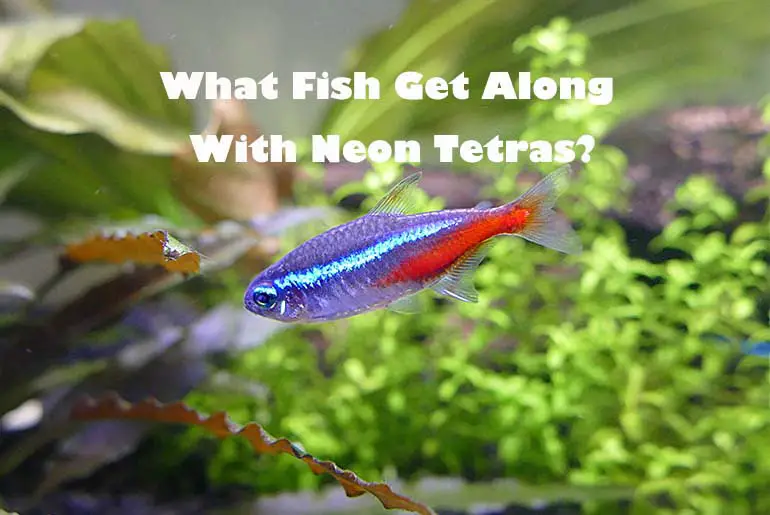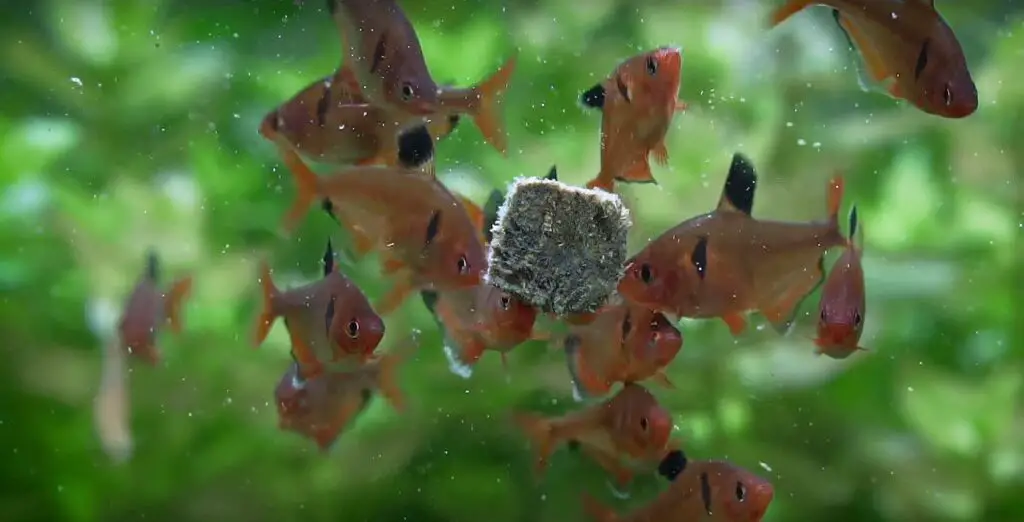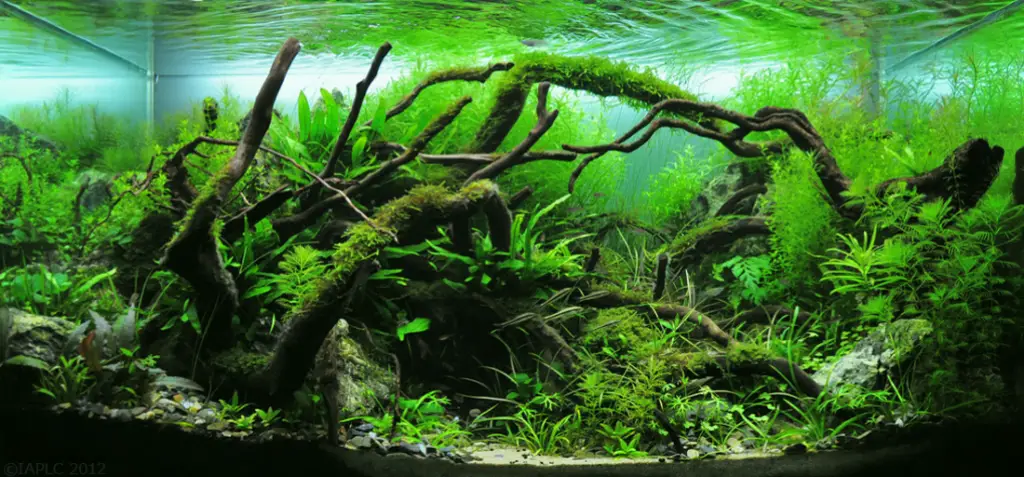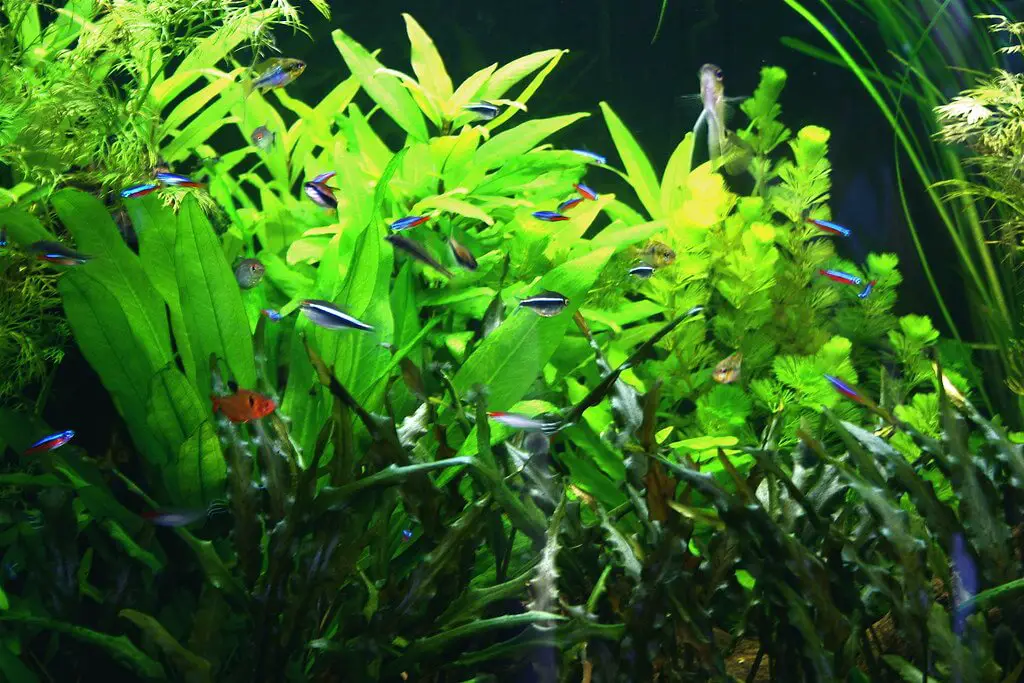GloFish Tetras are popular for aquarium fish because of their bright colors and relatively easy care. But how long do GloFish Tetras live? In this article, we will discuss the lifespan of GloFish Tetras and some factors that can affect their lifespan.
We will also provide some tips on how to care for your GloFish Tetras so that they can live a long and healthy life.
So, if you are thinking about getting GloFish Tetras or already have some, be sure to read on for more information on their lifespan and care.
Before going onto the main topic of this article, let me give you a short piece of information about GloFish Tetra.
About The GloFish Tetra
GloFish Tetras are super cool fish that light up like magic in your aquarium! How? Scientists did something amazing called genetic engineering when the fish were very young. They put special glowing colors into the fish’s genes, making them shine so bright. It’s not just Tetras; other fish like corydoras, pristella danios, barbs, and even sharks got the glowing treatment!
Two special kinds of Tetras got this magical change, too: the Black Widow Tetra and the Black Skirt Tetra.
The first turned into what we now know as GloFish Tetras, dazzling us with their vibrant colors. And the Black Skirt Tetra, with fancy long fins, became the enchanting Longfin GloFish Tetras.
But here’s the thing: changing their genes might affect how long and healthy they live.
This cool transformation is all about science, making fish look amazing! However, it’s essential to understand how this change could affect their health and how long they’ll stay with us.
How Long Do GloFish Tetras Live?
When given proper care, GloFish Tetras typically have a lifespan of 3 to 5 years. Providing an optimized living environment can extend their life expectancy. This includes:
- Balanced Diet: GloFish Tetras are omnivores and should be given a mix of live, frozen, and dry foods to keep them healthy.
- Clean Water: Maintaining a clean tank with water free of ammonia, nitrite, and nitrate is essential for their well-being.
- Adequate Tank Size: GloFish Tetras needs at least a 20-gallon tank to ensure enough space.
Ensuring these aspects of care will contribute to a longer and healthier life for your GloFish Tetras.
The Average GloFish Tetra Life Cycle
GloFish Tetras and their dazzling companions are truly a wonder of nature, yet they differ from the common misconceptions associated with alterations. They are not subject to dyes, injections, or individual modifications to achieve their vibrant hues.
The original aim behind introducing fluorescent proteins into their genetic makeup was to advance biomedical and environmental research. Scientists believed these modified fish could help detect pollution in their environment. However, these genetically altered fish found their niche in the ornamental fish pet trade as time progressed.
Being genetically altered, the offspring these GloFish produce will inherently possess the same captivating characteristics as their parents. This legacy of extraordinary colors is passed down from generation to generation. Today’s GloFish, descendants of the initial fluorescent fish, inherit their unique hues, preserving this genetic marvel and passing it on to their own offspring. The journey of a GloFish begins in a world where they are born beautiful, an inheritance owed to the marvels of genetic heritage.
Also Read: How To Know if Your GloFish Tetra is Carrying Eggs
GloFish Tetra Eggs
The life cycle of a GloFish Tetra begins with the female laying eggs. This process spans 2 to 3 days, during which the female lays several hundred eggs in each batch. However, not all of these eggs successfully hatch. The fish consume some, while others remain unfertilized.
Fry GloFish Tetra
After 2 to 3 days of laying and fertilizing the eggs, they hatch into fry. These tiny fish have an egg yolk attached to their belly, which serves as their initial source of nutrition. You will only need to provide additional food once their bodies fully absorb the egg yolk. Initially, the newly hatched fry don’t swim actively; they rest.
Once they have consumed the egg sac, it’s time to start feeding them with micro-fish food, which is readily available commercially. This phase marks their transition to active swimming as they explore and search for food. Approximately two weeks later, you can introduce ground flakes into their diet.
Juvenile GloFish Tetra
Juvenile GloFish Tetras undergo a significant transformation around the one-month mark, evolving from fry to juveniles. During this stage, their vibrant colors begin to manifest, making it a crucial period in their development. Maintaining optimal water quality and providing a nutritious diet becomes essential during this phase.
Young GloFish Tetra
As the young GloFish Tetras reach approximately two months of age, they transition to their young form and become sexually active. This stage allows for the separation of males and females. Increasing their food intake and introducing high-fat, protein-rich, and vegetable-based food is advisable to support their growth and overall well-being.
Adult GloFish Tetra
Upon reaching about six months of age, GloFish Tetras enter adulthood, marking a developmental milestone. Adult GloFish Tetras can grow up to 2.5 inches long, influenced by genetics and environmental factors. At this stage, their growth and development either come to a halt or significantly slow down, indicating the completion of their maturation process.
What Are The Most Common Causes of Death for GloFish Tetra?
Like any other fish, one of the significant factors that can impact the life expectancy of GloFish Tetra is water quality. Maintaining the right water parameters is vital to ensure the health and longevity of these vibrant aquatic companions. GloFish Tetras are highly sensitive to changes in water conditions, and any imbalance can lead to stress, disease, and, ultimately, a shortened lifespan.
Here are the major factors that can cause GloFish Tetras to die faster:
Poor Water Quality
Insufficient filtration and high ammonia, nitrite, or nitrate levels can significantly stress the GloFish Tetras, making them more susceptible to diseases and reducing their lifespan.
Inadequate Tank Size:
Keeping GloFish Tetras in small tanks can restrict their movement and cause stress, hindering their growth and overall well-being.
Improper Diet:
Providing an unbalanced or inadequate diet can lead to malnutrition and various health issues, affecting their immune system and, consequently, their longevity.
Incompatible Tankmates:
Introducing aggressive or incompatible tankmates can cause stress and injuries to the GloFish Tetras, leading to a decline in health and lifespan.
Unstable Water Temperature:
Fluctuations in water temperature outside their preferred range can cause stress and make them more susceptible to diseases, ultimately impacting their longevity.
10 Ways to Extend The Lifespan of Your GloFish Tetra?
So, we’ve discussed why GloFish Tetras don’t live very long. Now, let’s talk about how we can overcome those factors and help them live longer.
If you follow these care tips, your GloFish Tetra could live as long as five years!
The best tips to extend GloFish Tetra’s lifespan are:
Choosing Right Breeder
Choosing the right breeder can significantly impact the lifespan and overall health of GloFish Tetras. A reputable breeder who prioritizes ethical breeding practices and maintains high standards of care for their fish will produce healthier and more resilient GloFish Tetras.
Here are the reasons why you should buy your fish from reputable breeders:
- A reputable breeder ensures that the GloFish Tetras are bred from healthy parent stock.
- Breeders who maintain a clean and controlled environment reduce the risk of diseases and parasites in the fish.
- Ethical breeders maintain the integrity of the GloFish genetic modifications, ensuring the fish are true to their intended vibrant colors.
- Reputable breeders provide appropriate nutrition and care for the fish during their early stages of life. This early nourishment and care set a positive trajectory for the fish’s growth and development, contributing to a longer life.
- Responsible breeders often educate buyers about the specific needs of GloFish Tetras, offering guidance on proper care, tank setup, and suitable tankmates. This knowledge equips the new owners to provide optimal conditions for the fish, promoting their well-being and longevity.
Picking the Right Size Of Tank
Picking the right tank size is critical for the well-being and longevity of GloFish Tetras, following the golden rule that one inch of fish requires one gallon of water for a happy life. For instance, a school of 6 GloFish Tetras, typically reaching about 2.5 inches each, necessitates a minimum of a 15 to 20-gallon tank to thrive.
A larger tank ensures better water quality by diluting harmful waste and toxins like ammonia, supporting the nitrogen cycle. It offers adequate room for exercise, preventing undeveloped muscles and potential health issues.
Additionally, a spacious tank reduces stress and aggression among fish, promoting a healthier, more natural environment.
Insufficient space in smaller tanks can lead to deformities and spinal difficulties, making a well-sized tank crucial for their growth and preventing health problems.
Ultimately, the right tank size allows GloFish Tetras to exhibit their natural behaviors and ensures a happier, longer life in captivity.
Also Read: Are Glofish Tetras Aggressive? Are They Fighting Or Playing?
Right Water Parameters
In your fish tank, having clean water is super important for the health and happiness of your GloFish Tetras. Just as we need a clean environment to stay healthy, our fish buddies also need it.
Fish, including GloFish Tetras, make waste (like fish poop!) that can collect at the bottom of the tank. Uneaten food and algae can also pile up down there. All this stuff turns into ammonia, like how food becomes energy in our bodies. This is part of a natural process called the “nitrogen cycle.”
But too much ammonia and its next forms (nitrites and nitrates) can harm our fish pals. They can get stressed out or sick. To keep them safe, we need to do regular water changes, replacing about 10 to 20% of the tank water every week. Also, we should clean the filter in our tank every month. This helps remove the bad stuff from the water while keeping the good bacteria that help in the nitrogen cycle. So, think of it as giving your GloFish Tetras a clean and comfy home to enjoy their swim!
Oxygenated Water
Water, where our fishy pals live, comprises tiny parts called hydrogen and oxygen. Just like we breathe air to survive, fish use their gills to filter out oxygen from the water.
But here’s the thing – the more fish filter out oxygen, the less oxygen remains in the water. If there’s not enough oxygen, our fish friends must work harder to breathe, which can stress them out. Imagine if we had to run around all day just to catch a few breaths!
So, even though oxygen naturally comes from the air into the water, we sometimes need to add tiny air bubbles to ensure enough for our fish buddies. We use things like filter bubblers or air filters to do this. These gadgets create bubbles and stir the water, helping oxygen mix in faster. It’s like giving our fish a breath of fresh air!
There’s another cool trick, too – adding live plants to the aquarium. Tetra fish, by the way, absolutely love having these plants around. These plants release oxygen into the water, creating a happy and oxygen-rich environment for our GloFish Tetras to swim and play in!
Give Your GloFish Tetra A Good Place to Live
Ensuring a happy and healthy habitat for your GloFish Tetras is like giving them a cozy home in the underwater world. Imagine you’re a GloFish Tetra – you’d want a hiding place, right? Rocks, plants, and substrate in your tank mimic the natural feel of a fishy abode. It’s like having secret hideaways where Tetras can feel safe and relaxed.
Now, let’s talk about keeping the place tidy. Just like we appreciate a clean home, Tetras enjoys a clean tank. This is where the tank cleaning crew comes into play – snails, cory catfish, and otocinclus are the unsung heroes, helping keep the tank spick and span.
But remember, even in this underwater neighborhood, less is more. Don’t overcrowd the tank – consider it giving everyone their personal space. Following the “one inch of fish to one gallon of water” golden rule is a good way to strike that balance.
Oh, and let’s talk about relationships! It’s important to have the right mix of male and female GloFish Tetras. Too many males can lead to stress and tension, like having too many roosters in a henhouse! A good ratio is about 3 to 4 female Tetras for every male. It’s like having a harmonious neighborhood where everyone gets along. Creating this perfect fishy home guarantees that your GloFish Tetras live their best, most joyful underwater life!
Ideal Water Temperature
Just like we prefer a comfy room temperature, our GloFish Tetra buddies have their ideal warmth, too! For them to flourish and live their best fishy life, they like it around 72 to 80 degrees Fahrenheit. It’s like finding that perfect cozy spot in your room – not too hot or cold.
Once you’ve got the temperature range sorted, it’s about keeping it steady like a warm hug. You’d want a thermometer to check the tank’s temperature, kind of like how we peek at a thermostat. And to keep it just right, a heater is your go-to gadget.
Think of it like this – the automatic heater is the superhero that keeps the water temperature just perfect, set at 78 degrees, like setting the thermostat for that ideal warmth. It’s like a tailor-made suit for your GloFish Tetras, ensuring they’re in their happy place, swimming and living their best, vibrant life.
Right Quality Diet
Food is like fuel for our GloFish Tetras, and a good diet can make all the difference in their lifespan. Think of it as serving them a balanced and nutritious meal! Just like we need a balanced diet, Tetras need food that’s high in protein but not too fatty – it’s like offering them the best of the best.
Now, let’s talk portions. Imagine your meal fitting in your eye – that’s how big a Tetra’s stomach is! So, serving them just an eyeful of food is perfect. If it’s pellets, 2 to 4 pellets a couple of times a day is the way to go. It’s like serving them a snack, not a feast.
But hey, Tetras like a little variety, too! Just like we enjoy different snacks, they like hunting for their food. Treat them to some mosquito larvae, brine shrimp, or bloodworms once or twice a week – it’s like offering them their favorite treats!
And remember, growing up means changing tastes, even for Tetras. What’s good for little Tetras differs from what’s good for the grown-ups. So, choose their food wisely, keeping in mind the stage they’re at. It’s like giving them a menu just right for their age and appetite, ensuring a long and joyful journey for your vibrant GloFish Tetras.
Compatible Tankmates
Like we prefer good company, GloFish Tetras thrives better when surrounded by the right friends in their fishy neighborhood. Imagine living with buddies who get along and have similar tastes – it’s like having a great time always.
Choosing compatible tank mates means selecting fish that won’t cause stress or aggression. Imagine living with roommates who respect your space and personality. When Tetras are at ease and not constantly on edge, they’re happier, less stressed, and more likely to live a longer, peaceful life. It’s like having a harmonious family where everyone supports and cares for each other. So, the right tank mates are more than just good friends. They’re also the key to a joyful and extended life for our vibrant GloFish Tetras.
Here are some of the great tankmates for your GloFish Tetra:
- Neon Tetra
- Ember Tetra
- Guppies
- Danios
- Rasboras
- Mollies
- Loaches
- Harlequin Rasboras
Prevent Diseases
Just like us, GloFish Tetras can sometimes get sick. Diseases can still sneak in even if you’ve set up a perfect home for them. It’s like catching a cold, even when you’ve been careful.
Diseases like Ich, swim bladder disease, and fin rot are like common colds or flu for them. If not treated quickly, it’s like the illness spreading in a community.
Here’s the important part: recognizing the signs early, isolating the sick fish, and giving them the right treatment is like going to the doctor when you’re not feeling well. It helps stop the disease from spreading and saves lives. It’s like acting fast to help a friend who’s feeling down. By doing this, you save the infected fish and protect the rest of your GloFish Tetra gang, ensuring they continue to sparkle and swim happily in their aquatic home.
Reduce Stress
Creating a stress-free haven for GloFish Tetras is like giving them a cozy retreat where they can relax and be themselves. Picture it like a perfect home where everything is just right!
- First, choosing the right tank size is like having a spacious room – it prevents feeling cramped and overwhelmed.
- Next, we’ve got water conditions – keeping it clean and comfy is the foundation. Think of it as a soft bed to rest on.
- Next are hiding spots – it’s like having your own private space to escape and unwind.
- Adding the right tank mates is like having good neighbors who make your environment pleasant and enjoyable.
- Proper water filtration and oxygenation are like having a fresh breeze – it keeps everything clean and refreshing.
- The right diet is like having your favorite meal – it keeps you healthy and content.
- Arranging all these in a series is like building a dream home, ensuring your GloFish Tetras have a stress-free, happy, and long life in their aquatic paradise!
How To Tell If Your Fish Is Sick?
Like we can tell when someone’s not feeling well, we can spot signs of sickness in our fishy pals. It’s like noticing when a friend has a fever or a runny nose.
Here are some common signs that your GloFish Tetra might not be feeling their best:
Changes in Behavior:
- Unusual swimming patterns (dodging, spinning, floating at the top, or sinking to the bottom)
- Less activity, hiding more than usual, or being unusually aggressive
Physical Changes:
- Faded or discolored patches on their body
- Fins clamped to the body, torn or rotting
Appetite and Eating Habits:
- Loss of appetite, not interested in food, or spitting out food
- Rapid weight loss or sudden bloating
Breathing and Gills:
- Rapid or heavy breathing
- Visible redness, swelling, or discharge around the gills
Skin and Scales:
- Abnormal growths, lumps, or lesions on the skin
- White spots resembling grains of salt (a common sign of Ich)
Do Male Or Female GloFish Tetra Live Longer?
Male and female GloFish Tetras typically have similar lifespans, and there isn’t a significant difference in longevity between the two genders. The lifespan of a GloFish Tetra is more influenced by factors like water quality, diet, tank conditions, and overall care rather than gender. Providing optimal living conditions and proper care will help both male and female GloFish Tetras live a longer and healthier lives.
How Long Can GloFish Tetra Live Without Food?
GloFish Tetras, like most fish, can typically survive for about 1 to 2 weeks without food, depending on various factors such as their overall health, age, and the conditions of their environment.
However, it’s important to note that while they can survive this period without food, it’s not healthy for them. Going without food for an extended period can weaken their immune system, lead to health issues, and potentially shorten their lifespan.
Regular and balanced feeding is essential for the well-being and longevity of GloFish Tetras. Establishing a consistent feeding schedule and providing them with appropriate and nutritious food is recommended to ensure they stay healthy and vibrant. If you need to be away or can’t feed them for a few days, consider using automatic fish feeders or arranging for someone to feed them in your absence.
Do GloFish Tetra Live Longer With a Filter?
Yes, having a filter in the tank can contribute to a longer and healthier life for GloFish Tetras. A filter helps maintain good water quality by removing harmful substances such as ammonia and nitrites, which can harm the fish’s health.
Clean and properly filtered water provides a more suitable and stress-free environment, positively impacting the longevity of GloFish Tetras. It also aids in oxygenation, further enhancing their overall well-being. However, it’s important to regularly maintain and clean the filter to ensure it functions effectively in providing a healthy habitat for the fish.
FAQs
Here are answers to some of the questions about GloFish you might like answers to.
Is GloFish Hard To Keep Alive?
No, these GloFish are quite easy to keep alive and will not give you a hard time while raising them.
These GloFish are sensitive to constant changes and fluctuations in the water parameters and might develop diseases afterward.
If you are maintaining water parameters and taking good care of their diet, keeping them even in the community tank will be easy.
Can GloFish Live Alone?
Apparently, GloFish are schooling fish that prefer to stay in the company of their look-alike.
So, isolating them or keeping a GloFish alone in a whole tank will stress your GloFish, and you might lose your appetite and grow weak.
Loneliness and depression can make anyone lose their calm and composition; the same happens when a GloFish is left alone.
They will eventually die after developing diseases and weakening their immunity system.
How Do I Know If My GloFish Is Dying?
Several signs will indicate the nearing death of your GloFish, so make sure you observe the behavior of your GloFish closely.
Here are the signs your GloFish will show when they are on the verge of death.
- Gasping for breath on the surface of the water.
- Color fading
- Low Respiration rate
- Loss of appetite
- Change in the swimming patterns
- Sluggish and stays on the bottom of the tank
- Mentation of GloFish
Final Thought
GloFish Tetras, born from genetic innovation, brings a kaleidoscope of colors to our aquariums. Understanding their lifecycle and providing an ideal habitat are crucial steps in their care journey.
Balanced nutrition, suitable tank mates, and attentive disease prevention measures contribute to a longer and healthier life. A well-maintained filter further ensures their vitality by maintaining water purity and oxygen levels.
As we delve into the marvels of genetic alteration and prioritize their well-being, we unlock the secrets to a vibrant and enduring life for these aquatic wonders. Let us continue to cherish and nurture GloFish Tetras, keeping their colors shimmering in our underwater realms.




